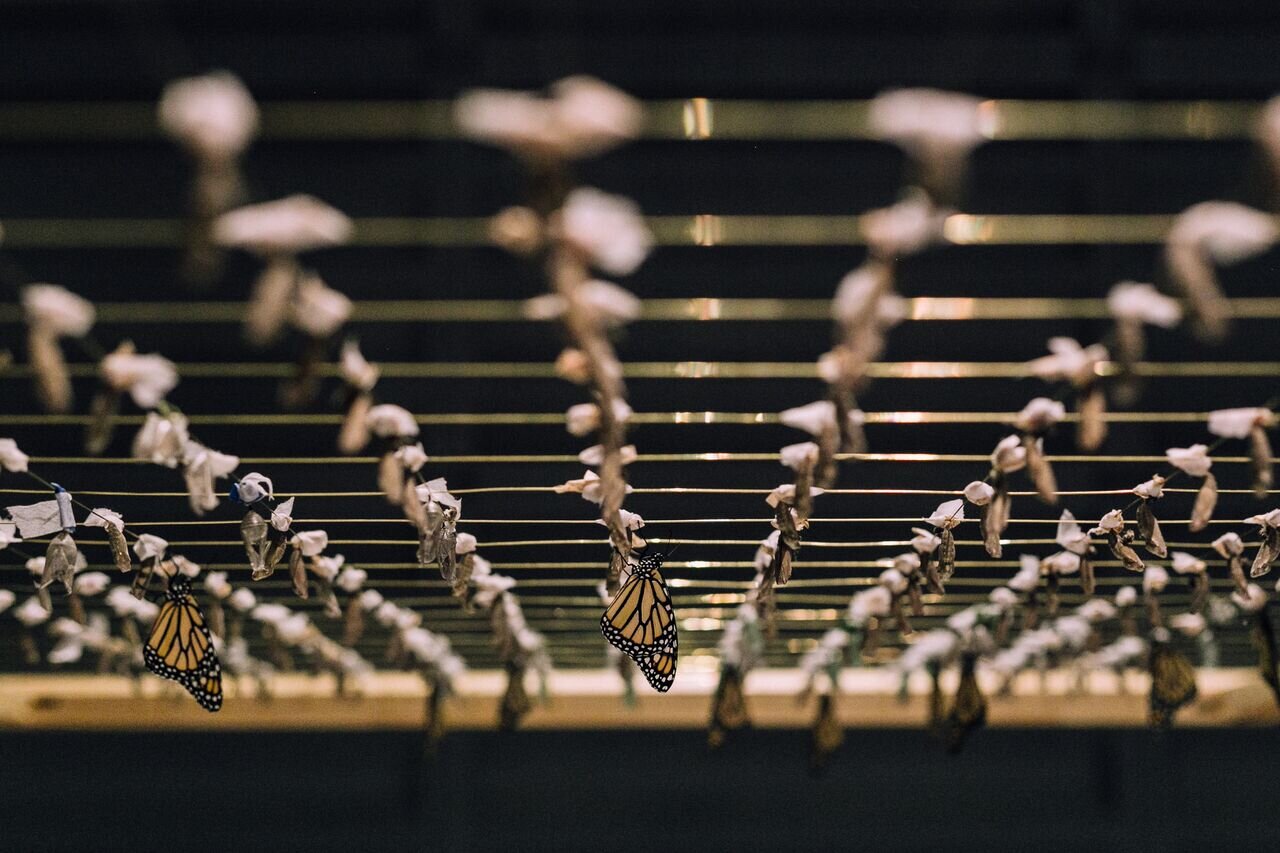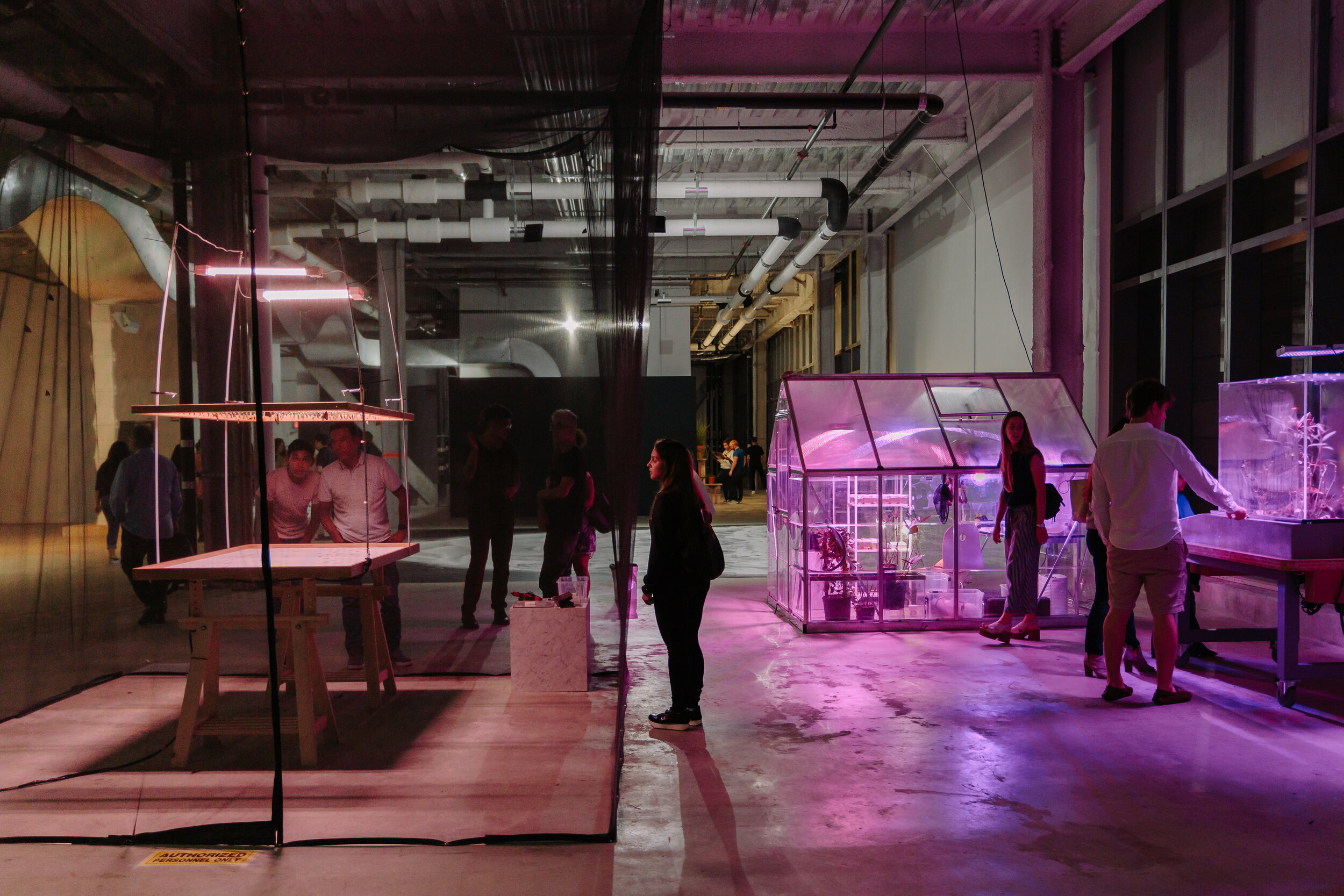WaveMaker Grantee: Franky Cruz
Written by Franky Cruz and Locust Projects
Interview with the Artist
Tell us about your WaveMaker project:
The project Vivarium Meconium started with a performance where I repaired the broken wings off of living butterflies. This performance piece was titled One Fifth of an Ounce and it was held in the greenhouse research laboratory in the Spinello Gallery, I thought it to be a great gesture of empathy for something that is so fragile like our relationship with the natural world. The caterpillars came into the studio and never left. Raising them from egg to butterfly. Upon emergence from their chrysalis they hang, spread their wings and release meconium, a pigmented secretion that gravity pulls onto the surface below. At that moment I realized nature is already making a beautiful painting. In order to capture these emergence secretions, the studio morphed into more of a vivarium lab focused on raising these caterpillars and releasing these native butterflies.
The first two large pieces were made with 420 butterflies thanks to a commissioned project with Locust Projects in 2017. Since then, the lab has been installed and activated in the Museum of Contemporary Art North Miami where the paintings where shown and lectures where given on pollinator and native plant gardening alongside Jean Sarmiento, creator of SunKeeper Solutions and co-founder of the Love the Everglades Movement. Vivarium Meconium Lab activations in Brickell City Centre where during Miami Art Week, the third large-scale painting was started in an 11x11x11 ft mesh enclosure and over 200 caterpillars were raised in the garden and green house and open to the public for two weeks. Thanks to the Oolite Arts Ellie award and the WaveMaker grant this project was able to be shown and continue to stay active. The laboratory is in the Milk District Studio in Little Haiti where we’re currently working on the sixth large-scale painting along with many smaller works. Since its inception, we have released almost 3000 native butterflies.
What was the easiest aspect of this project? What was the most challenging? Did you learn something new? What do you wish you had done different? What went perfectly?
There are a lot of challenges with this project, as you can imagine, this project is costly and very time-consuming since each caterpillar takes about a month to raise for me to collect the splatters and they consume a lot of specific host plants. Caterpillars for the most part have a very picky diet which has led to this project going outside of the artist studio, spreading and planting pollinator and partnering with gardens in the neighborhood in order to have a safe space to release the butterflies and have a place to harvest the sufficient amount of caterpillars needed to create these paintings. The first showing of this project at Locust Projects was postponed by Hurricane Irma and the paintings made from this process where originally going to be shown in my first solo exhibition on April 20, 2020, which was also postponed due to the COVID-19 crisis, something about the Lorenz butterfly effect—the chaos is the only perfection.
Tell us what you're most excited about as a result of this project? Has it inspired a new work, collaborations, direction? Has it brought new opportunities for expanding it through other grants or exhibitions? What, where and when? Tell us more...
I'm very excited about the results of this project but even more excited to see where this project can go, curious about the different hued secretions that other butterflies have all around the world and in other countries. I’m forever curious about the mysteries the nature still has for us to unlock, so it can be a mobile laboratory. Also, the lab plans on emerging another 3000 butterflies. To produce new work we’ll definitely need a larger studio with its own garden as well. Currently, the Vivarium Meconium network of gardens in the community includes the butterfly garden at The Center for Subtropical Affairs. The butterflies continue to emerge and we are seeking funding and setting goals to activate the geodesic dome version of the outdoor butterfly laboratory and garden this fall, on a rooftop somewhere in our community. I’m always collaborating in this dance with these winged creatures to continue this process.
In one sentence - what one thing about doing this project will stay with you?
Other than the butterfly tattoo I got my leg sort of like a Boy Scout badge in order to honor this process and how it's changed completely and changed my studio completely, will be the metaphor of a sluggish ever consuming creature going through a giant transitional death like metamorphosis where the the old body is digested and converted to a gooey mucus that will now resemble itself to become an epic being with the wings creating chaos lines in the invisible and now has all these new sensors and technologies and instead of consuming the plant it now gets its nourishment from the nectar, pollinating the flowers it dances on.
ABOUT THE ARTIST
Franky Cruz (b. 1984, Santo Domingo, Dominican Republic) received his BFA in Painting from the New World School of the Arts, Miami in 2011. Solo exhibitions have been staged at Locust Projects and Spinello Projects, in Miami, respectively. He has participated in group exhibitions such as Monarchs: Brown and Native Contemporary Artists in the Path of the Butterfly at MOCA North Miami, the FREE! Fair at Brickell City Centre (Miami), and Mere Façade at Spinello Projects (Miami). He has participated in artist residencies such as HomeBase Project (Berlin) and AIRIE: Artists in Residence in Everglades (Miami). Cruz lives and works in Miami.
Franky Cruz’s ongoing project Vivarium Meconium has been staged in various forms over the past four years across Miami, including shows at Locust Projects, the Brickell City Centre, and the Museum of Contemporary Art, North Miami. His practice has led him to experiment with water flow systems, found objects (both manmade and organic), and new painting methods thanks to the natural life cycles of Monarch butterflies. The Vivarium Meconium Laboratory (VML) has grown into a butterfly-rearing and painting laboratory where Cruz adapts native species conservation techniques in diligently raising the creatures with both scientific methodologies and personal, deeply-vested care. The pollinator is raised from egg-to-larvae-to-chrysalis, which is then suspended above a sheet of paper that will capture the colorful liquid secretions – remnants of their metamorphosis – in shades of umber, ochre, magenta and green. The cycle achieves completion as the butterflies are released into the South Floridian ecosystem. Cruz describes VML as a “butterfly painting machine with butterflies as its exhaust,” but also as an important environmental indicator; a “canary in a coal mine” that alerts us as to the condition or dangers in the biosphere. VML is a call to action encouraging the general public to support regenerative and balanced ecosystems, while exploring new ways of seeing in new methods of painting. See his available works at spinelloprojects.com
Franky Cruz received a Cycle 5 WaveMaker Grant in 2019. Since 2015, WaveMaker Grants have awarded $399,000 in grants to 77 Miami’s most visionary artists, collectives, and curators.
WaveMaker Grants at Locust Projects is made possible by support from the Andy Warhol Foundation for the Visual Arts and is part of the Warhol Foundation's Regional Regranting Program. Part of a national network of Warhol-initiated regranting programs, WaveMaker Grants is the first in the southeast. For more information about the Warhol Foundation's Regional Regranting Program, please click here.





